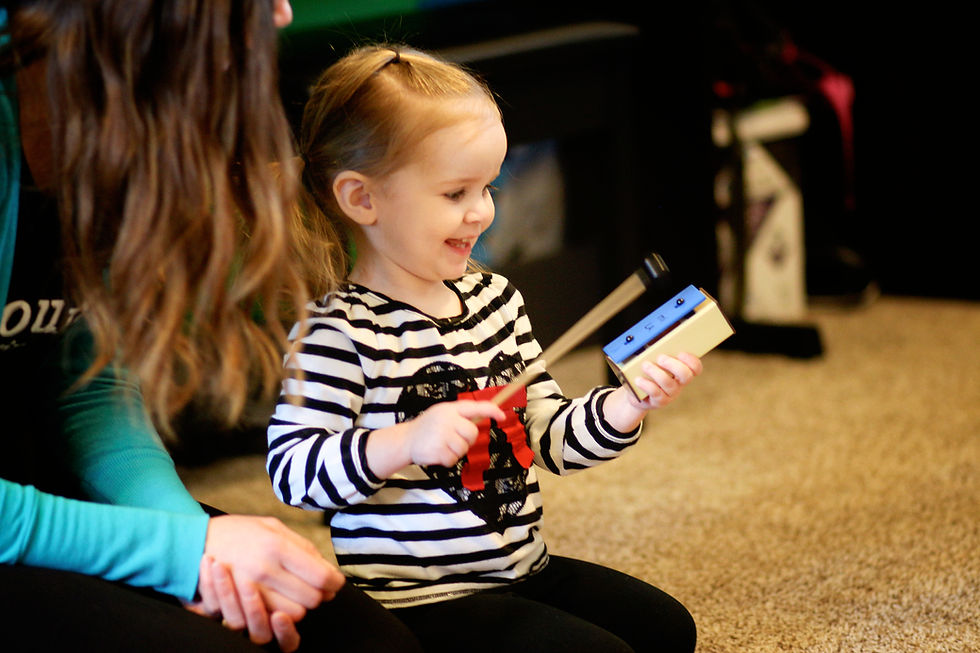Orff’s Influence on Let's Play Music
- Let's Play Music

- Aug 16, 2024
- 3 min read
Updated: Sep 23

When Let's Play Music creator, Shelle Soelberg, selected the best elements to include in the curriculum, she included tenets from pedagogical masters Orff, Dalcroze, and Kodaly that would achieve a total musicianship program.
The Orff Approach shares several common goals with Let's Play Music, including a concern with fundamental experiences and foundational skills for a comprehensive musical training.
At a Let's Play Music teachers' symposium years ago, we were treated to a session with certified Orff instructor, Anne M. Fenell, M.Ed. She taught us more about the influence of Orff on Let's Play Music, and she highlighted the common approaches seen in Orff and Let's Play Music classes:
we learn through play,
we use hands-on instruments,
we learn by doing,
and we create lifelong musicians.
Carl Orff (1895–1982)

The Orff Approach to music education is based on fundamental principles rather than a specific method or manual. These principles are incorporated into LPM’s lesson plans.
Carl Orff, a Munich-born conductor and composer, gained fame with operas like Der Mond and Der Kluge.
Orff’s pedagogy mirrors his compositions, using melody, rhythm, and movement to teach music naturally, much like language. He believed that everyone is naturally inclined to play and create music.
Orff developed his approach in the 1920s, integrating music, movement, speech, and drama. Initially for young women, it evolved for younger children, with a series of music volumes published between 1950 and 1954. Orff continued to refine and promote the approach throughout his life.
We Learn Through Play
"Since the beginning of time, children have not liked to study. They would much rather play, and if you have their interests at heart, you will let them learn while they play". - Carl Orff
Children naturally play, imitate, and experiment, which Orff identified as key to learning. Music, like language, thrives in an environment where children can safely explore and express themselves through music, drama, and speech. The Orff Approach is child-centered, emphasizing musical literacy through creativity and play.
Musicality involves improvisation, experimentation, and imagination, not just literacy. A playful environment fosters creative learning, thus enhancing musical experience through discovery, invention, and composition.
In Let's Play Music and other Orff-based programs, teachers create a playful atmosphere, allowing children to comfortably explore and develop new musical skills. Dr. Fennel noted, "Creativity is the currency of the 21st century."
Hands-On Instruments

Orff believed that musical learning requires tactile, hands-on experiences. Children start with body percussion (clapping, tapping) and singing, which are essential before introducing rhythm and melodic percussion instruments.
Let's Play Music tone bells align with Orff's approach, allowing for easy rearrangement to teach patterns and harmonies. The bells’ solfege syllables are engraved in two keys (C and F), helping students understand that musical patterns and intervals remain consistent across keys, simplifying transposition.
Lifelong Musicians
The Orff Approach and Let's Play Music both aim for a deep musical training, focusing on fundamental experiences and skills. The goal is not just literacy but to inspire a lifelong enjoyment of music, encouraging students to become composers and musicians.
Anne Fennell, M.Ed., emphasizes teaching with the goal of developing lifelong musicians. While 80% of students may not continue playing their instrument after high school, the 20% who do have often developed a love for creating music and collaborating with others. Fennell believes our world needs creative problem solvers, not just musicians who read and play music. The Orff Approach emphasizes creative music and movement, helping children engage as composers and active participants, beyond just literacy.
Learn by Doing

The Orff Approach emphasizes learning by doing, where students engage in activities that foster an appreciation for music’s aesthetics. Let's Play Music adopts this method, focusing on active participation rather than theoretical lectures. For example, students learn about chords through practice before learning their formal names.
Orff’s principle is "Experience first, then intellectualize," aligning with the Chinese proverb, "Tell me, I forget. Show me, I remember. Involve me, I understand." This hands-on approach is evident when students arrange chords on a staff or discover melodies in games. At the symposium, Fennell had teachers learn by doing, creating, and performing rhythmic work.
Songs used in teaching are short, repetitive, and adaptable, often from folk songs or nursery rhymes. Both Orff and Let's Play Music start with major and minor scales, progressing from imitation to improvisation within a supportive environment.
The Orff Approach incorporates percussion instruments and rhythmic activities. Let's Play Music integrates these principles with the keyboard, creating a comprehensive three-year curriculum that emphasizes a strong musical foundation based on play.



Comments